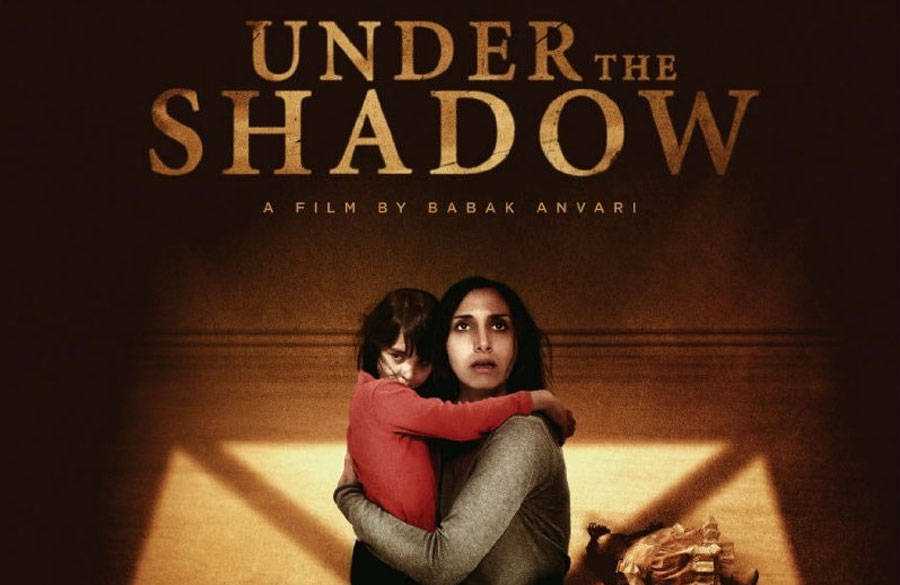
The UK has its best shot in over a decade at picking up a Best Foreign Language Film Oscar nomination, diverging from its usual Welsh-language submission to select British-Iranian writer/director Babak Anvari’s Farsi-language debut feature. Having garnered considerable buzz on the festival circuit, most notably at Sundance, Under the Shadow picks up where Ana Lily Amirpour’s A Girl Walks Home Alone at Night (2014) left off in telling a story from the Iranian diaspora which filters traditional narratives through the cultural conventions of an adopted homeland, proving once again how infinitely adaptable the horror genre is. Under the Shadow tells a personally inflected story through the prism of a psychological chiller.
Under the Shadow takes place in Tehran the midst of the Iran-Iraq War and the aftermath of the Iranian Cultural Revolution – Anvari spent the first five years of his life under the shadow of these upheavals, and the film draws on the experiences of his family. Shideh (Narges Rashidi) has been accused of subversion by the revolutionary government and is blacklisted from the medical college where she was studying to become a doctor. Shideh’s doctor husband, Iraj (Bobby Naderi), is conscripted into the army, leaving Shideh alone with her young daughter, Dorsa (Avin Manshadi), as Tehran is bombarded. When an undetonated missile rips through the ceiling of their apartment complex, Dorsa is convinced that the missile has brought with it a Djinn, a malevolent spirit from Arabian mythology.
Under the Shadow is a tautly constructed piece which succeeds in delivering scares while carrying a socio-political undercurrent; there are multiple layers at work, with the war and the post-revolution backlash grumbling in the background. Anvari draws on a range of sources – everything from classics like Cat People (1942) and The Haunting (1963) to modern fare like Guillermo Del Toro and Korean Horror – without being beholden to any of them. Stylistically, the film is an amalgam of naturalism and theatrics; beginning like a Farhadi-esque domestic drama and slowly morphing into a woozy psychodrama as DP Kit Fraser’s bobbing and tilting handheld camerawork becomes gradually more erratic in an attempt to mimic the motions of Shideh’s spiralling psyche. The film’s sound design is deftly executed, investing the smallest of creak or gentlest of breeze with foreboding; while the visual effects have a tangible quality which gives them the texture of ’80s ‘practical’ effects.
Rashidi’s central performance transcends the ‘woman in peril’ horror conventions to become something more psychologically weighty; a Polanski-esque descent into madness in which the line between fantasy and reality slowly blurs and the psychic wounds of this baleful climate are exposed. Though Under the Shadow is first and foremost a horror film, the context of the era informs the film’s exploration of confinement and belief. What could have been little more than another ‘haunted house’ film feels like an allegorical study of female aspiration set against patriarchal truculence; of reason doing battle with superstition; of a culture creating its monsters; of the victimized being scared by their own reflection.
The hallmark of smart horror is its ability to be effective sans subtext, for that exterior layer to work independent of any thematic underpinnings that may be there, intentionally or otherwise. Under the Shadow succeeds in being familiar enough to sate hardcore horror fans and inventive enough to appeal to a general audience, approaching a familiar conceit from a fresh angle, invoking genre staples without wallowing in nostalgia or parody. A stellar genre debut has been a rite of passage for many a cinematic luminary, and Anvari’s tense, claustrophobic, ambiguous offering seems likely to be a springboard to greater things.
Follow Daniel Palmer on Twitter at @mrdmpalmer.
Filed under: Film, TV & Tech
Tagged with: Avin Manshadi, Bobby Naderi, foreign film, horror, Iran, Narges Rashidi, Sundance, Tehran



Comments